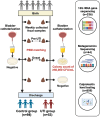Pathogen-specific alterations in intestinal microbiota precede urinary tract infections in preterm infants: a longitudinal case-control study
- PMID: 38561312
- PMCID: PMC10986765
- DOI: 10.1080/19490976.2024.2333413
Pathogen-specific alterations in intestinal microbiota precede urinary tract infections in preterm infants: a longitudinal case-control study
Abstract
Urinary tract infections (UTIs) are among the most common late-onset infections in preterm infants, characterized by nonspecific symptoms and a pathogenic spectrum that diverges from that of term infants and older children, which present unique diagnostic and therapeutic challenges. Existing data on the role of gut microbiota in UTI pathogenesis in this demographic are limited. This study aims to investigate alterations in gut microbiota and fecal calprotectin levels and their association with the development of UTIs in hospitalized preterm infants. A longitudinal case-control study was conducted involving preterm infants admitted between January 2018 and October 2020. Fecal samples were collected weekly and analyzed for microbial profiles and calprotectin levels. Propensity score matching, accounting for key perinatal factors including age and antibiotic use, was utilized to match samples from UTI-diagnosed infants to those from non-UTI counterparts. Among the 151 preterm infants studied, 53 were diagnosed with a UTI, predominantly caused by Enterobacteriaceae (79.3%) and Enterococcaceae (19.0%). Infants with UTIs showed a significantly higher abundance of these families compared to non-UTI infants, for both Gram-negative and positive pathogens, respectively. Notably, there was a significant pre-UTI increase in the abundance of pathogen-specific taxa in infants later diagnosed with UTIs, offering high predictive value for early detection. Shotgun metagenomic sequencing further confirmed the dominance of specific pathogenic species pre-UTI and revealed altered virulence factor profiles associated with Klebsiella aerogenes and Escherichia coli infections. Additionally, a decline in fecal calprotectin levels was observed preceding UTI onset, particularly in cases involving Enterobacteriaceae. The observed pathogen-specific alterations in the gut microbiota preceding UTI onset offer novel insight into the UTI pathogenesis and promising early biomarkers for UTIs in preterm infants, potentially enhancing the timely management of this common infection. However, further validation in larger cohorts is essential to confirm these findings.
Keywords: Preterm infants; calprotectin; microbiome; urinary tract infection; virulence factor.
Conflict of interest statement
No potential conflict of interest was reported by the author(s).
Figures






Similar articles
-
Gut Microbiome Implication and Modulation in the Management of Recurrent Urinary Tract Infection.Pathogens. 2024 Nov 21;13(12):1028. doi: 10.3390/pathogens13121028. Pathogens. 2024. PMID: 39770288 Free PMC article. Review.
-
Role of Gut and Urinary Microbiome in Children with Urinary Tract Infections: A Systematic Review.Diagnostics (Basel). 2025 Jan 3;15(1):93. doi: 10.3390/diagnostics15010093. Diagnostics (Basel). 2025. PMID: 39795621 Free PMC article. Review.
-
Profound Pathogen-Specific Alterations in Intestinal Microbiota Composition Precede Late-Onset Sepsis in Preterm Infants: A Longitudinal, Multicenter, Case-Control Study.Clin Infect Dis. 2021 Jul 1;73(1):e224-e232. doi: 10.1093/cid/ciaa1635. Clin Infect Dis. 2021. PMID: 33561183
-
Dynamics and Crosstalk between Gut Microbiota, Metabolome, and Fecal Calprotectin in Very Preterm Infants: Insights into Feeding Intolerance.Nutrients. 2023 Nov 20;15(22):4849. doi: 10.3390/nu15224849. Nutrients. 2023. PMID: 38004243 Free PMC article.
-
S100A8 and S100A9 Are Important for Postnatal Development of Gut Microbiota and Immune System in Mice and Infants.Gastroenterology. 2020 Dec;159(6):2130-2145.e5. doi: 10.1053/j.gastro.2020.08.019. Epub 2020 Aug 15. Gastroenterology. 2020. PMID: 32805279
Cited by
-
Non-coding RNAs in bladder cancer, a bridge between gut microbiota and host?Front Immunol. 2024 Nov 19;15:1482765. doi: 10.3389/fimmu.2024.1482765. eCollection 2024. Front Immunol. 2024. PMID: 39628486 Free PMC article. Review.
-
The gut microbiome and metabolome in children with a first febrile urinary tract infection: a pilot study.Pediatr Nephrol. 2025 May 14. doi: 10.1007/s00467-025-06782-6. Online ahead of print. Pediatr Nephrol. 2025. PMID: 40369126
-
Gut Microbiome Implication and Modulation in the Management of Recurrent Urinary Tract Infection.Pathogens. 2024 Nov 21;13(12):1028. doi: 10.3390/pathogens13121028. Pathogens. 2024. PMID: 39770288 Free PMC article. Review.
-
Role of Gut and Urinary Microbiome in Children with Urinary Tract Infections: A Systematic Review.Diagnostics (Basel). 2025 Jan 3;15(1):93. doi: 10.3390/diagnostics15010093. Diagnostics (Basel). 2025. PMID: 39795621 Free PMC article. Review.
-
Exploring Childhood Lower Urinary Tract Symptoms (LUTS), Urinary Tract Infections (UTIs) and the Microbiome-A Systematic Review.Life (Basel). 2025 Apr 30;15(5):730. doi: 10.3390/life15050730. Life (Basel). 2025. PMID: 40430156 Free PMC article. Review.
References
Publication types
MeSH terms
Substances
LinkOut - more resources
Full Text Sources
Medical
